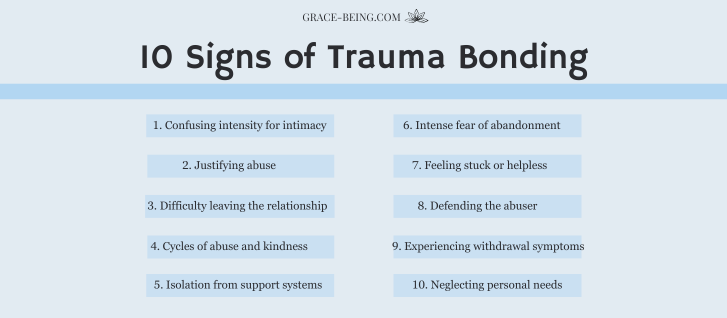10 Signs of Trauma Bonding
Understanding the 10 signs of trauma bonding is vital. Without this knowledge, you might overlook the fact that you’re trapped in a trauma bond, prolonging your entanglement in a harmful relationship. This can lead to mistaking a toxic cycle of abuse for love.
When I discovered my own trauma bond with a narcissist, it shifted my view of the relationship. This realization brought clarity, and though it was a gradual process, I ultimately broke free and began a transformative healing journey.
Now I’m dedicated to spreading awareness and guiding others through their healing process. Recognizing these 10 trauma bonding signs is the first step towards liberation and growth.
If you’re struggling to heal from narcissistic abuse, I warmly welcome you to my Narcissistic Abuse Recovery Program. It’s an easy self-paced online course which you can do at your own pace. My signature program combines scientific and spiritual tools for holistic healing of the body, mind, and spirit.
Identifying the Key Indicators: The 10 Signs of Trauma Bonding

1. Confusing Intensity for Intimacy
Being with a narcissist often involves a rollercoaster of emotions, often mistaken for deep intimacy. This is a key indicator in answering, “How do you know if you have a trauma bond?”
In these relationships, affection and attention can rapidly switch to criticism or neglect, creating a confusing cycle. This push-and-pull dynamic, where emotional highs are followed by lows, is often misconstrued as intimacy but is actually a manipulation tactic.
Recognizing this pattern is essential in identifying a trauma bond, distinguishing it from the consistent, nurturing intimacy found in healthy relationships.
2. Justifying Abuse
One of the most telling signs of a trauma bond is the tendency to justify abuse. Often, those entangled in such bonds find themselves rationalizing their partner’s harmful behaviors.
They may attribute these actions to external pressures like stress at work, challenging childhoods, or even temporary lapses in judgment. In some cases, they might even blame themselves, thinking they provoked the abuse or didn’t do enough to keep the peace.
This pattern of justification obscures the reality of the situation. Abuse, in any form, is never justifiable.
It’s crucial to recognize that external factors do not excuse harmful behavior, nor does any supposed shortcoming on your part.
3. Difficulty in Leaving the Relationship
A pivotal aspect of the 10 signs of trauma bonding is the profound difficulty in leaving the relationship. Even when you’re aware of the harm it causes, there’s an overpowering emotional pull that anchors you to your partner. This paradox is at the heart of a trauma bond.
You might intellectually understand that the relationship is damaging. But emotionally, you’re entwined with your partner to the extent that the thought of leaving feels unimaginable. This bond often stems from intermittent reinforcement—moments of kindness or affection interspersed with abuse—that creates a hope for change or a return to the ‘good times.’
Acknowledging this difficulty is a significant step in addressing trauma bond symptoms. It involves recognizing the discrepancy between understanding the harm and feeling unable to leave.
This realization is vital in beginning the process of detaching from the toxic cycle and seeking a healthier path forward.
Related: Karma Narcissist Quotes
4. Repeated Cycles of Abuse and Kindness
A defining symptom of trauma bonding is enduring cycles of abuse and kindness. This creates a confusing, hard-to-break bond. The relationship swings between extremes. You experience moments of bliss and intense affection, known as ‘narcissist love bombing‘. Here, the narcissist seems utterly infatuated with you.
Yet, this shifts to phases of abandonment, devaluation, and punishment. These include the silent treatment and discarding, also known as the ‘narcissistic abuse cycle’. These contrasting experiences are key symptoms of trauma bonding. When the relationship peaks, it feels fulfilling, making the lows more devastating.
This erratic pattern fosters dependency on the abuser for emotional validation. It traps the victim in a cycle that feels impossible to escape.
5. Isolation from Support Systems
Isolation from friends and family is a key sign of a trauma bond. This often happens gradually and subtly. It’s a result of the relationship’s controlling nature. The narcissist may start by criticizing your close relationships. Or they might monopolize your time and attention.
Soon, you find yourself increasingly distant from those who were once pillars in your life. This isolation is one of the signs of a trauma bond. It’s a strategy to increase your dependence on the abuser.
This distance from support systems makes recognizing and leaving the abusive relationship more challenging.
6. Intense Fear of Abandonment
A profound fear of abandonment is a critical aspect in understanding how to know if you’re trauma bonded. This fear is not just a worry; it’s an overwhelming dread of being left alone. It can drive you to tolerate mistreatment and abuse, as the thought of abandonment seems far worse than the current suffering.
This fear is often exploited by the abuser, who may threaten to leave or suggest you’re unworthy of love. Such tactics reinforce the trauma bond, making you more willing to endure abuse to avoid abandonment.
Recognizing this fear and its impact on your decision-making is a significant step in identifying and addressing a trauma bond.
7. Feeling Stuck or Helpless
Feeling stuck or helpless is one of the common signs of trauma bonding in relationships. It’s not just about physical constraints; it’s a psychological trap. You may feel like there’s no way out of the relationship, despite recognizing its harmful aspects. This sense of entrapment often goes hand in hand with a diminishing sense of self-worth.
The abuser may contribute to this feeling by undermining your confidence and independence. This erosion of self-esteem makes it harder to envision a life outside the relationship.
Breaking free from this mindset is essential when it comes to healing from narcissistic abuse. It involves rebuilding self-esteem and recognizing your own strength and worth, independent of the relationship.
8. Defending the Abuser
Defending the abuser is a complex and confusing aspect of trauma bonds. In these situations, you might find yourself instinctively protecting your partner when speaking to others. This often involves downplaying or even denying the abuse. It’s not about being dishonest; it’s a coping mechanism rooted in the trauma bond.
This defense might stem from a mix of fear, loyalty, and a distorted sense of responsibility for the abuser’s actions. You may rationalize their behavior or feel compelled to maintain a façade of a healthy relationship.
Acknowledging this behavior is a crucial step in healing. It involves facing the reality of the abuse and recognizing that defending the abuser perpetuates the cycle.
9. Experiencing Withdrawal Symptoms
One of the most indicative trauma bond withdrawal symptoms is experiencing physical and emotional withdrawal when separated from the abuser. This reaction is akin to addiction.
Just like substance dependence, you may feel a range of symptoms when away from your partner. These can include anxiety, restlessness, intense longing, and even physical discomfort.
This withdrawal is a powerful sign of how deeply the trauma bond has affected you. It shows how the relationship has become a source of both pain and perceived comfort.
10. Neglecting Personal Needs
Neglecting personal needs is one of the most common 10 signs of trauma bonding. This often happens to the detriment of your health and well-being. It’s not just about sacrificing your preferences; it’s about consistently putting their desires, opinions, and comfort first, neglecting your own basic needs in the process.
This pattern can manifest in various ways, such as ignoring your physical health, emotional needs, or personal goals.
The focus shifts entirely to pleasing the abuser, reinforcing the bond and the cycle of abuse.
What to Do Next After Identifying the 10 Signs of Trauma Bonding
If you’ve found yourself resonating with most of the 10 signs of trauma bonding, it’s a significant indicator of your current situation in a potentially harmful relationship. If these signs feel familiar, it shows that you’re in a vulnerable position, but also that you’re gaining the awareness needed to initiate change.
At this pivotal moment, I recommend considering my signature program, “The Path to Healing & Empowerment”. This program is specifically designed for individuals struggling with trauma bonding symptoms.
It’s a unique blend of science-backed techniques and spiritual practices that I’ve gathered and refined throughout my own healing journey. I’ve combined these elements to create a comprehensive and accessible path to recovery.
“The Path to Healing & Empowerment” is not just about overcoming trauma bonding, but also about building a stronger, more resilient, and empowered self.
FAQs about the 10 Signs of Trauma Bonding
The 10 signs of trauma bonding include:
1. Confusing intensity for intimacy
2. Justifying abuse
3. Difficulty leaving the relationship
4. Cycles of abuse and kindness
5. Isolation from support systems
6. Intense fear of abandonment
7. Feeling stuck or helpless
8. Defending the abuser
9. Experiencing withdrawal symptoms
10. Neglecting personal needs
You may be trauma bonded if you find yourself justifying abusive behavior, feeling unable to leave despite knowing it’s harmful, experiencing intense emotional highs and lows, and prioritizing your abuser’s needs over your own well-being. Recognizing these patterns is key to identifying a trauma bond.
Additional Reading
Self Healing From Narcissistic Abuse
Setting Boundaries with a Narcissist
How Does a Narcissist React When They Can’t Control You?







